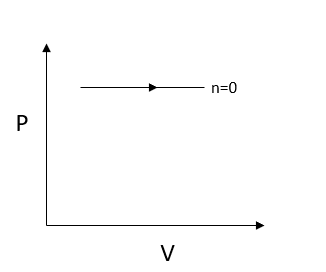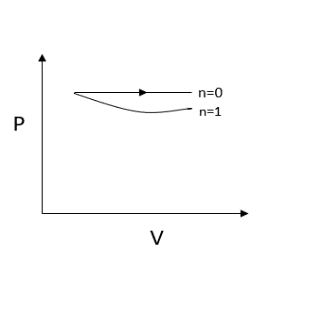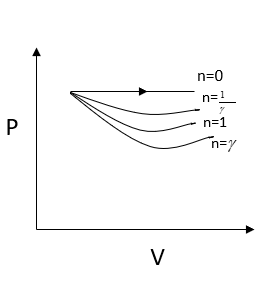
Initial and final pressures and volumes of a gas in a thermodynamic process are ${P_i}$, ${V_i}$ and ${P_f}$, ${V_f}$, respectively. If $P{V^n}$=constant, then the amount of work done is:
$\left( A \right)$ minimum for $n = \gamma $
$\left( B \right)$ minimum for $n = 1$
$\left( C \right)$ minimum for $n = 0$
$\left( D \right)$ minimum for $n = \dfrac{1}{\gamma }$
Answer
218.7k+ views
Hint: Here the initial and final pressure and volume are given. Using the equation of the gas, plot the graph of pressure versus volume for different values of \[n\] . The area under the graph pressure versus volume gives the work done by the gas. Then using the graph determine the minimum work done by the gas. Here the given thermodynamic process is an adiabatic process.
Complete step by step answer:
A system undergoing physical changes in such a way that neither the heat is allowed to enter the system from the surrounding nor allowed to leave the system to the surrounding is called the adiabatic process. In adiabatic compression, the temperature increases as work is done on the gas. In adiabatic expansion, the temperature decreases as the work is done by the gas.
We know that
$P{V^n}$= constant
$P = \dfrac{C}{{{V^n}}}$
Where $C$ is a constant,$P$ is the pressure,$V$ is the volume.
 Now for $n = 0$, we get
Now for $n = 0$, we get
$P = \dfrac{C}{{{V^0}}} = C$
The pressure is constant since $P = C$.
Now let us substitute $n = 1$, we get $P = \dfrac{C}{V}$
Here we obtain a rectangular hyperbola since the pressure is inversely proportional to volume.

Now $n = \gamma $, we get
$P = \dfrac{C}{{{V^\gamma }}}$
We know that the adiabatic constant $\gamma $ is greater than one, we can write
${V^\gamma } > V$
And we can also write
$\dfrac{C}{{{V^\gamma }}} < \dfrac{C}{V} - - - - - \left( 1 \right)$
From the above equation, I can also write
$\dfrac{C}{{{V^{\dfrac{1}{\gamma }}}}} > \dfrac{C}{V} - - - - - \left( 2 \right)$
From comparing the two-equation we can write
$\dfrac{C}{{{V^\gamma }}} < \dfrac{C}{{{V^{\dfrac{1}{\gamma }}}}}$

Here work done is given by the area under the curve. It is clear that work is done is minimum for $n = \gamma $
Hence option$\left( A \right)$is the correct option.
Note: Pressure, Volume, Temperature changes suddenly from ${P_1}$ , ${V_1}$,${T_1}$ to ${P_2}$,${V_2}$${T_2}$ if a gas is compressed suddenly in the thermally insulated flask. This is an adiabatic process. In adiabatic compression, the temperature increases as work is done on the gas. In adiabatic expansion, the temperature decreases as the work is done by the gas. A system undergoing physical changes in such a way that neither the heat is allowed to enter the system from the surrounding nor allowed to leave the system to the surrounding is called the adiabatic process.
Complete step by step answer:
A system undergoing physical changes in such a way that neither the heat is allowed to enter the system from the surrounding nor allowed to leave the system to the surrounding is called the adiabatic process. In adiabatic compression, the temperature increases as work is done on the gas. In adiabatic expansion, the temperature decreases as the work is done by the gas.
We know that
$P{V^n}$= constant
$P = \dfrac{C}{{{V^n}}}$
Where $C$ is a constant,$P$ is the pressure,$V$ is the volume.
 Now for $n = 0$, we get
Now for $n = 0$, we get$P = \dfrac{C}{{{V^0}}} = C$
The pressure is constant since $P = C$.
Now let us substitute $n = 1$, we get $P = \dfrac{C}{V}$
Here we obtain a rectangular hyperbola since the pressure is inversely proportional to volume.

Now $n = \gamma $, we get
$P = \dfrac{C}{{{V^\gamma }}}$
We know that the adiabatic constant $\gamma $ is greater than one, we can write
${V^\gamma } > V$
And we can also write
$\dfrac{C}{{{V^\gamma }}} < \dfrac{C}{V} - - - - - \left( 1 \right)$
From the above equation, I can also write
$\dfrac{C}{{{V^{\dfrac{1}{\gamma }}}}} > \dfrac{C}{V} - - - - - \left( 2 \right)$
From comparing the two-equation we can write
$\dfrac{C}{{{V^\gamma }}} < \dfrac{C}{{{V^{\dfrac{1}{\gamma }}}}}$

Here work done is given by the area under the curve. It is clear that work is done is minimum for $n = \gamma $
Hence option$\left( A \right)$is the correct option.
Note: Pressure, Volume, Temperature changes suddenly from ${P_1}$ , ${V_1}$,${T_1}$ to ${P_2}$,${V_2}$${T_2}$ if a gas is compressed suddenly in the thermally insulated flask. This is an adiabatic process. In adiabatic compression, the temperature increases as work is done on the gas. In adiabatic expansion, the temperature decreases as the work is done by the gas. A system undergoing physical changes in such a way that neither the heat is allowed to enter the system from the surrounding nor allowed to leave the system to the surrounding is called the adiabatic process.
Recently Updated Pages
Two discs which are rotating about their respective class 11 physics JEE_Main

A ladder rests against a frictionless vertical wall class 11 physics JEE_Main

Two simple pendulums of lengths 1 m and 16 m respectively class 11 physics JEE_Main

The slopes of isothermal and adiabatic curves are related class 11 physics JEE_Main

A trolly falling freely on an inclined plane as shown class 11 physics JEE_Main

The masses M1 and M2M2 M1 are released from rest Using class 11 physics JEE_Main

Trending doubts
JEE Main 2026: Application Form Open, Exam Dates, Syllabus, Eligibility & Question Papers

Derivation of Equation of Trajectory Explained for Students

Hybridisation in Chemistry – Concept, Types & Applications

Understanding the Angle of Deviation in a Prism

Understanding Collisions: Types and Examples for Students

Understanding Atomic Structure for Beginners

Other Pages
JEE Advanced Marks vs Ranks 2025: Understanding Category-wise Qualifying Marks and Previous Year Cut-offs

Units And Measurements Class 11 Physics Chapter 1 CBSE Notes - 2025-26

NCERT Solutions For Class 11 Physics Chapter 8 Mechanical Properties Of Solids

Motion in a Straight Line Class 11 Physics Chapter 2 CBSE Notes - 2025-26

NCERT Solutions for Class 11 Physics Chapter 7 Gravitation 2025-26

How to Convert a Galvanometer into an Ammeter or Voltmeter




